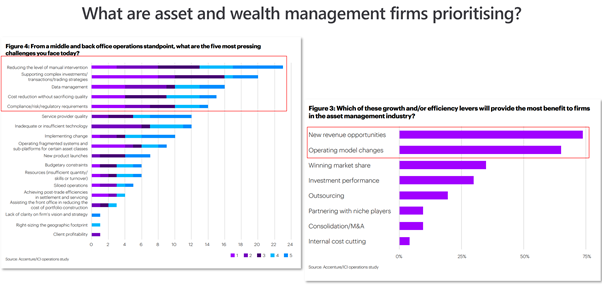
Build intelligent operations by empowering employees and connecting data
To gain an advantage in today’s world, capital market firms must not only evolve their operations but find new ways to compete. In our report, Creating a blueprint for UK competitiveness, we found that 46 percent of UK organisations fall into the bottom quadrant of competitiveness. In order to build sustainable growth, organisations need to look at combining empowered employees, technology and future readiness. Intelligent operations lie at the heart of an organisation’s value chain.
Operations connect the back, middle and front offices. They are critical to the success of an investment organisation’s core business. However, there is an increase in regulatory requirements, daily performance returns, client reporting challenges, an increasing flow of unstructured data, and a heightened demand for data governance. This can create operational challenges, lower productivity and stagnate growth.
In a recent study by Accenture, they outline the top priorities for asset and wealth management organisations. It’s to no surprise that new revenue streams, removal of manual tasks and operations optimisations rank at the top of the list.

Organisations are understandably frustrated with common concerns centred around data quality. These can create poor employee experiences. Disconnected silos and lack of intelligent technology makes it harder for people to do their best work. With the help of automation tools your employees can focus on the work that matters – driving innovation, wellbeing and productivity.
Reduce organisational risk and improve the employee experience
End User Computing (EUC) are applications that are not managed or developed in an environment that employs robust IT controls. They’re typically things like spreadsheets, databases or reporting tools that are created and maintained by separate business units within their individual processes.
In a recent article, End-user computing: A problem everyone has but nobody wants to own, we outlined that EUCs are prone to both risk and operational costs. From a risk perspective, there are dependencies on the users and from cost, there are often many inefficiencies with the manual effort required to extract, transform, and even enter data.
It comes as no surprise that this causes inconsistency and inefficiency within organisational silos. This can lead to costly and time-consuming daily reconciliations between systems. Lack of governance makes a bad problem worse. This can lead to increased costs, and risks such as data being deleted, the wrong data being shared and the lack of security that comes with running a spreadsheet. Lack of integration with existing business applications, misstatement of financials due to data entry or calculation errors in spreadsheets, data redundancy and fraud are all barriers preventing firms from being able to maximise the value of its data.
Low code platforms such as Power Platform, can help modernise operations and deliver innovation, turning EUCs into End User Solutions. A low code platform provides a complete server-side and client front end framework that covers areas such as data distribution, security, and permissions. It also addresses the issue of data compliance.
This helps prevent inconsistency and inefficiency, reducing operational silos and freeing your employees to spend more time on value-add work.

Set the foundation for intelligent operations with automation
As we can see from above, data is often scattered across systems and different formats. Organisations often struggle to automate processes without extensive integration efforts. It is not infrequent that an organisation can have thousands of separate dispersed licenses. This results in many solutions that do not speak to each other without a common data source. You can replace multiple tools across the organisation with a single license, template and low code app.
When it comes to inefficiency, a 2018 PwC report found there is an ongoing cost to manage and update code equal to 20 percent of the development cost. This is also reduced by 74 percent. For example, today’s largest investment banks pay between $3.5b-$4 billion in compensation costs to support a global workforce of 65,000 to 70,000.
This presents a great opportunity to revisit manual processes from a new perspective. According to Microsoft’s benchmark data, when considering reduced total cost of ownership with reduced IT effort for apps development, retiring third party applications and maintenance, increasing staff efficiency and time to market as well as reducing risk of security breach, this can result in an average of £2.5m savings back into the business.
illimity Bank, an Italian-based cloud native bank leveraged low code solutions to improve document handling. Using Power Platform, the underwriting team has been able to reduce processing times for employee loan requests from an hour per request to just 20 minutes. It can now respond to requests in a matter of days rather than a full week. They have saved a total of 15 hours a month.
“We’ve used the automation capabilities in Microsoft Power Platform to dramatically improve the efficiency of our employee loans process. The time savings have been a valuable return on our investment.”
Filipe Teixeira, Chief Information Officer, illimity Bank
Improve time to market and innovation with intelligent operations
There are four fundamental changes happening in the industry. Together, they create a compound impact that’s impossible to ignore for those who want to maintain industry leadership.
- The workforce is changing with 75 percent of employees expected to be ‘millennials’ by 2025. This comes with high expectations for business applications at work as well as a self-service mentality.
- The digital demand is surging. More apps are being created in the next five years than in the last 40 years.
- There are also challenges which come with the global climate as well as a skill shortage. This creates urgency when it comes to modernisation of applications.
- Power Platform and low code platforms reduce pressure on IT, reduce cost to change and allow organisations to move and innovate faster.
Providing data in new ways and at a faster rate than ever before have an incremental benefit compound growth rate of 1 percent. By leveraging intelligent operations, you’re on your journey to achieving sustainable growth.
Find out more
Get in touch with your business applications specialist for an Envisioning Workshop on the benefits of PowerPlatform.
Register for the webinar: Economic Impact of Power Apps
Learn more: Browse learning paths on Microsoft Learn
Read the whitepaper: PowerApps and Microsoft Flow Governance and Deployment
Discover real world stories: Power Platform in organisations
About the author

Marina Arnaout has been successfully helping businesses embrace innovative strategies that enhance digital investments. Currently, she is focused on modernising business processes and applications working within financial services organisations in UK. Marina holds a postgraduate degree from London School of Economics, with a focussed academic research on impact of automation and AI on financial services.




